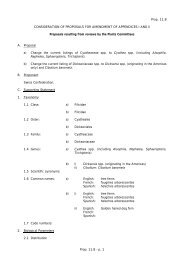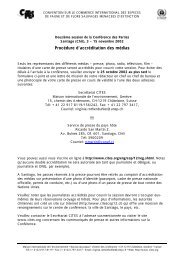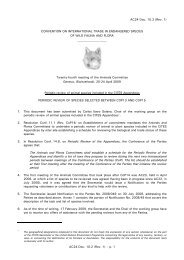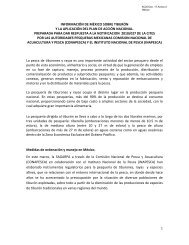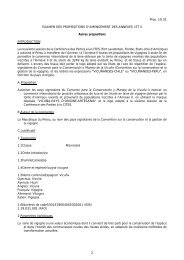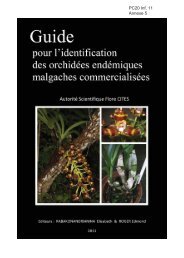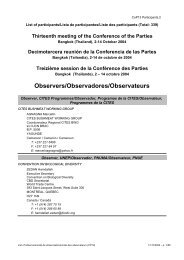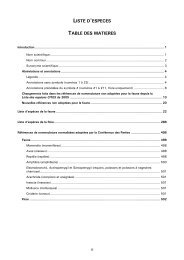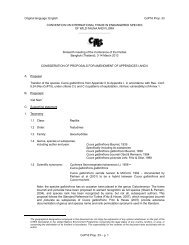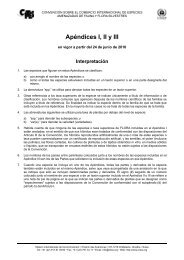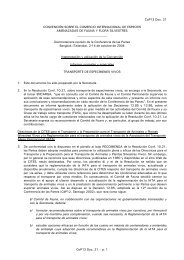Lamna nasus - Cites
Lamna nasus - Cites
Lamna nasus - Cites
You also want an ePaper? Increase the reach of your titles
YUMPU automatically turns print PDFs into web optimized ePapers that Google loves.
Draft Proposal to list <strong>Lamna</strong> <strong>nasus</strong> in Appendix II - prepared by Germany in January 2012<br />
assessments (DFO 2005a, Campana and Gibson 2008, Campana et al. 2010b, ICCAT/ICES 2009, Figure 13)<br />
estimated the total population size for this stock as 188,000–195,000 sharks (22–27% of original numbers<br />
prior to the fishery starting; possibly 800,000 to 900,000 individuals) but only 9,000–13,000 female spawners<br />
(12–16% of their original abundance and 83–103% of abundance in 2001). Stock size elsewhere is unknown.<br />
4.3 Population structure<br />
Genetic studies identified two isolated populations, in the North Atlantic and the Southern oceans (Pade et al.<br />
2006). Tagging studies in the Atlantic support two distinct Northwest and Northeast Atlantic stocks. Long<br />
distance movements occur within each stock, with fish tagged off the UK recaptured off Spain, Denmark and<br />
Norway, travelling up to 2,370km. ADD RESULTS FROM SOSF FUNDED TAGGING WORK IN PREP.<br />
Only one tagged shark crossed the Atlantic (Ireland to eastern Canada, 4,260km) (Campana et al. 1999,<br />
Kohler & Turner 2001, Kohler et al. 2002, Stevens 1976 & 1990). Porbeagles tagged in Canadian waters<br />
move onto the high seas for unknown periods of time (Campana and Gibson 2008), including to pupping<br />
grounds in the Sargasso Sea (Campana et al. 2010a). Stock boundaries in the Southern Hemisphere are<br />
unclear. The Southwest and Southeast Atlantic stocks appear to extend into the adjacent Pacific and Indian<br />
Oceans. The structure of exploited populations is highly unnatural, with very few large mature females<br />
present. This results in an extremely low reproductive capacity in heavily fished, depleted stocks (e.g.<br />
Campana et al. 2001).<br />
4.4 Population trends<br />
Population trends, summarised in Table 3, are presented in the context of Annex 5 of Conf. 9.24 (Rev. CoP15)<br />
and FAO (2001). The estimated generation time for L. <strong>nasus</strong> is at least 18 years in the North Atlantic, and 26<br />
years in the Southern Oceans (Table 2). The three-generation period against which recent declines should be<br />
assessed is therefore 54 to 78 years, greater than the historic baseline for most stocks. Trends in mature<br />
females (the effective population size 2 ) must be considered where possible. Stock assessments for this species<br />
usually show a correlation between declines in landings, declining catch per unit effort (CPUE), and reduced<br />
biomass because market demand and prices have always been high and there has, until recently, been little or<br />
no restrictive management. Where no stock assessments are available, CPUE, mean size and landings are<br />
therefore used as metrics of population trends.<br />
Figure 2. Available decline trends for porbeagle <strong>Lamna</strong> <strong>nasus</strong> stocks (from FAO 2010 and other sources<br />
cited in Section 4, Status and Trends)<br />
Stock declines from historic baseline are indicated in black, more recent declines that have occurred during<br />
the past 3 generations (50 years) in grey. A range is indicated where appropriate for some stock assessment<br />
model results. The coloured sections identify decline thresholds to within




